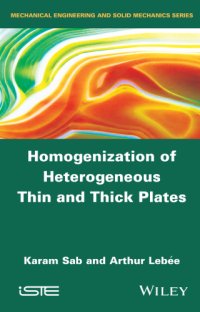
Ebook: Homogeneization and Periodic Structures
Author: Lebée Arthur, Sab Karam
- Tags: Plates (Engineering), TECHNOLOGY & ENGINEERING--Drafting & Mechanical Drawing, Electronic books, TECHNOLOGY & ENGINEERING -- Drafting & Mechanical Drawing
- Series: Iste
- Year: 2015
- Publisher: John Wiley & Sons Incorporated
- City: London
- Edition: 1st
- Language: English
- epub
Formulation of the generalized Reissner plate model 90 5.3.3. The subspaces of generalized stresses 91 5.3.4. The generalized Reissner equilibrium equations 95 5.3.5. Characterization of the generalized Reissner stress solution 97 5.3.6. The generalized Reissner kinematics 98 5.3.7. Derivation of the direct formulation of the generalized Reissner plate model 100 5.3.8. The relationships between generalized plate displacements and 3D displacements 102 5.4. Derivation of the Bending-Gradient plate model 106 5.5. The case of isotropic homogeneous plates 109 5.6. Bending-Gradient or Reissner-Mindlin plate model? 111 5.6.1. When does the Bending-Gradient model degenerate into the Reissner-Mindlin's model? 112 5.6.2. The shear compliance projection of the Bending-Gradient model onto the Reissner-Mindlin model 113 5.6.3.;Introduction xi Chapter 1. Linear Elasticity 1 1.1. Notations 1 1.2. Stress 3 1.3. Linearized strains 6 1.4. Small perturbations 8 1.5. Linear elasticity 8 1.6. Boundary value problem in linear elasticity 10 1.7. Variational formulations. 11 1.7.1. Compatible strains and stresses 11 1.7.2. Principle of minimum of potential energy 13 1.7.3. Principle of minimum of complementary energy 14 1.7.4. Two-energy principle 15 1.8. Anisotropy 15 1.8.1. Voigt notations 15 1.8.2. Material symmetries 17 1.8.3. Orthotropy 20 1.8.4. Transverse isotropy 22 1.8.5. Isotropy 23 Part 1. Thin Laminated Plates 27 Chapter 2. A Static Approach for Deriving the Kirchhoff-Love Model for Thin Homogeneous Plates 29 2.1. The 3D problem 29 2.2. Thin plate subjected to in-plane loading 32 2.2.1.;Thick Homogeneous Plate Subjected to Out-of-Plane Loading 67 4.1. The 3D problem 67 4.2. The Reissner-Mindlin plate model. 69 4.2.1. The 3D stress distribution in the Kirchhoff-Love plate model 69 4.2.2. Formulation of the Reissner-Mindlin plate model 71 4.2.3. Characterization of the Reissner-Mindlin stress solution 72 4.2.4. The Reissner-Mindlin kinematics 73 4.2.5. Derivation of the direct formulation of the Reissner-Mindlin plate model 74 4.2.6. The relations between generalized plate displacements and 3D displacements 76 Chapter 5. Thick Symmetric Laminated Plate Subjected to Out-of-Plane Loading 81 5.1. Notations 81 5.2. The 3D problem 82 5.3. The generalized Reissner plate model 85 5.3.1. The 3D stress distribution in the Kirchhoff-Love plate model 85 5.3.2.;This book gives new insight on plate models in the linear elasticity framework tacking into account heterogeneities and thickness effects. It is targeted to graduate students how want to discover plate models but deals also with latest developments on higher order models. Plates models are both an ancient matter and a still active field of research. First attempts date back to the beginning of the 19th century with Sophie Germain. Very efficient models have been suggested for homogeneous and isotropic plates by Love (1888) for thin plates and Reissner (1945) for thick plates. However, the extension of such models to more general situations --such as laminated plates with highly anisotropic layers-- and periodic plates --such as honeycomb sandwich panels-- raised a number of difficulties. An extremely wide literature is accessible on these questions, from very simplistic approaches, which are very limited, to extremely elaborated mathematical theories, which might refrain the beginner. Starting from continuum mechanics concepts, this book introduces plate models of progressive complexity and tackles rigorously the influence of the thickness of the plate and of the heterogeneity. It provides also latest research results. The major part of the book deals with a new theory which is the extension to general situations of the well established Reissner-Mindlin theory. These results are completely new and give a new insight to some aspects of plate theories which were controversial till recently.;The shear stiffness projection of the Bending-Gradient model onto the Reissner-Mindlin model 115 5.6.4. The cylindrical bending projection of the Bending-Gradient model onto the Reissner-Mindlin model 116 Chapter 6. The Bending-Gradient Theory 117 6.1. The 3D problem 117 6.2. The Bending-Gradient problem 119 6.2.1. Generalized stresses 119 6.2.2. Equilibrium equations 121 6.2.3. Generalized displacements 122 6.2.4. Constitutive equations 122 6.2.5. Summary of the Bending-Gradient plate model 123 6.2.6. Field localization 123 6.3. Variational formulations 125 6.3.1. Minimum of the potential energy 126 6.3.2. Minimum of the complementary energy 127 6.4. Boundary conditions 128 6.4.1. Free boundary condition 129 6.4.2. Simple support boundary condition 130 6.4.3. Clamped boundary condition 131 6.5. Voigt notations 131 6.5.1.;The plane-stress 2D elasticity problem 33 2.2.2. Application of the two-energy principle 34 2.2.3. In-plane surfacic forces on deltaOmega " 336 2.2.4. Dirichlet conditions on the lateral boundary of the plate 38 2.3. Thin plate subjected to out-of-plane loading 40 2.3.1. The Kirchhoff-Love plate model 41 2.3.2. Application of the two-energy principle 47 Chapter 3. The Kirchhoff-Love Model for Thin Laminated Plates 53 3.1. The 3D problem 53 3.2. Deriving the Kirchhoff-Love plate model 55 3.2.1. The generalized plate stresses 55 3.2.2. Static variational formulation of the Kirchhoff-Love plate model 56 3.2.3. Direct formulation of the Kirchhoff-Love plate model 58 3.3. Application of the two-energy principle 59 Part 2. Thick Laminated Plates 65 Chapter 4.
Download the book Homogeneization and Periodic Structures for free or read online
Continue reading on any device:

Last viewed books
Related books
{related-news}
Comments (0)